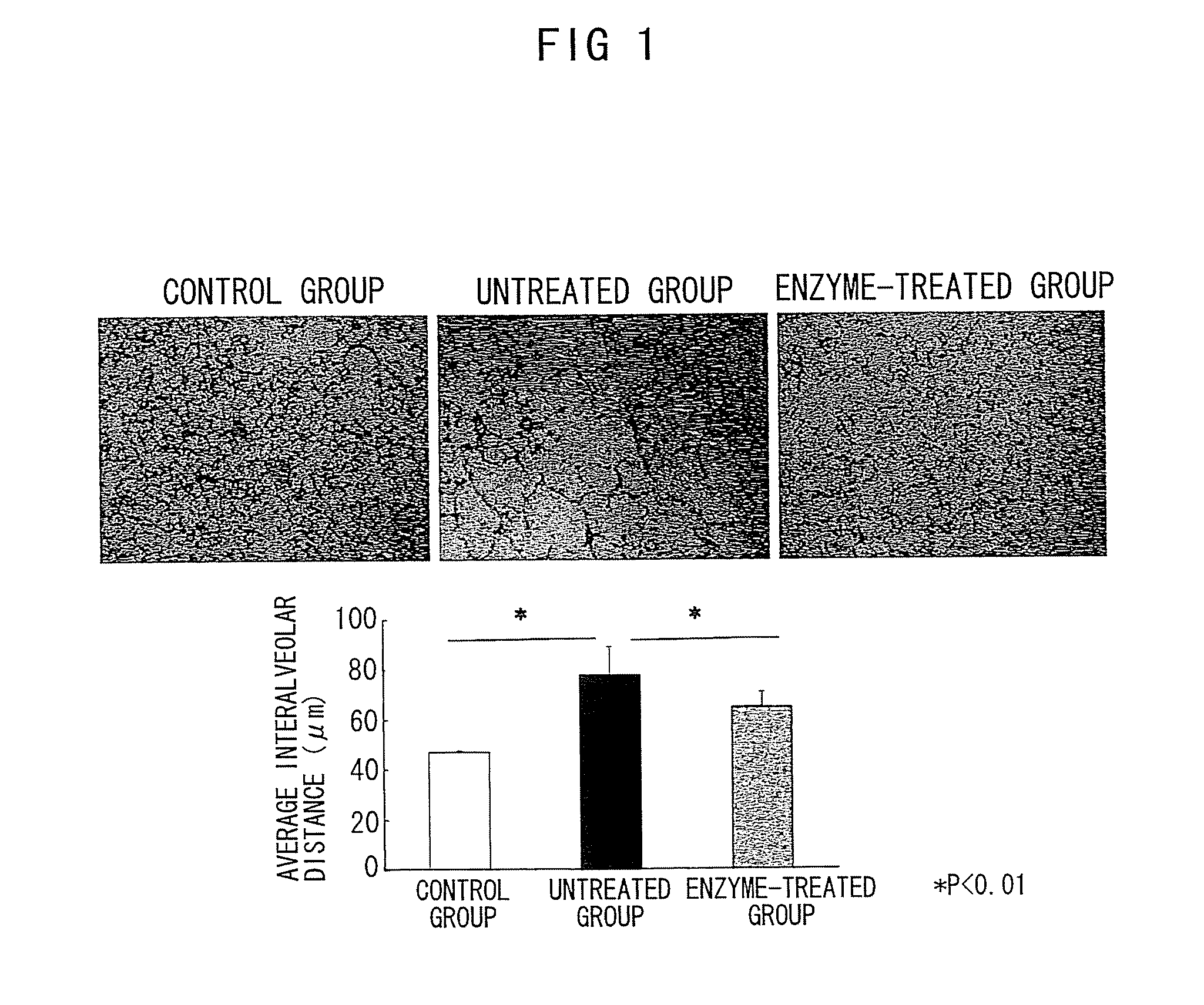Agents for improving chronic obstructive pulmonary diseases
a technology of obstructive pulmonary disease and agents, which is applied in the field of agents for improving chronic obstructive pulmonary disease, can solve the problems of not yet clinically applicable, difficult to treat pulmonary emphysema using current therapeutic methods other than lung transplantation, etc., and achieve the effects of suppressing emphysematous lesions, suppressing cspg deposition, and promoting cspg degradation
- Summary
- Abstract
- Description
- Claims
- Application Information
AI Technical Summary
Benefits of technology
Problems solved by technology
Method used
Image
Examples
example 1
The Effect of Chondroitinase ABC in Suppressing Emphysematous Lesions in Pulmonary Emphysema Model Mice
[0203]A standard mouse model of pulmonary emphysema made by intratracheal administration of porcine pancreatic elastase (PPE) was used in this Example. This classical model is widely used as a pulmonary emphysema model because of its superior reproducibility and simplicity.
[0204](Non-patent Documents: Karlinsky, J. B. et al., Am Rev Respir Dis., 1978, 117, 1109-1133; Otto-Verbeme, C. J. et al., Protective effect of pulmonary surfactant on elastase-induced emphysema in mice, Eur Respir. J., 1992, 5, 1223-1230; Janoff, A. et al., Prevention of elastase-induced experimental emphysema by oral administration of a synthetic elastase inhibitor, Am Rev Respir Dis., 1980, 121, 1025-1029; Christensen, T. G. et al., Irreversible bronchial goblet cell metaplasia in hamsters with elastase-induced panacinar emphysema, J Clin Invest., 1977, 59, 397-404; Lucey, E. C. et al., Remodeling of alveolar...
example 2
The Effect of Chondroitinase ABC in Suppressing the Deposition of Proteoglycans in Pulmonary Emphysema Model Mice
[0214]In this Example, the proteoglycan-suppressing effect of chondroitinase ABC was examined and compared using lung tissue samples from pulmonary emphysema model mice. The sections obtained by the same method as in Example 1 were fixed in acetone (Sigma Aldrich Japan) for ten minutes, and then washed with phosphate buffer. An anti-chondroitin sulfate proteoglycans (CSPG) antibody (clone CS56, mouse monoclonal antibody, 10 μg / ml; Seikagaku) was added as the primary antibody, and the sections were reacted at room temperature for one hour. Then, the secondary antibody reaction was conducted using a Histofine Mouse Stain Kit (Nichirei; used for mouse monoclonal antibodies), and DAB substrate (Nichirei) was added thereto for the enzymatic color reaction. The samples were observed under a light microscope (Leica Microsystems).
[0215]The obtained histological images are shown i...
example 3
The Effect of Chondroitinase ABC in Suppressing the Accumulation of Proteoglycans in Pulmonary Emphysema Model Mice
[0217]The CSPG deposited as shown in Example 2 is known to adsorb chemokines, which are substances that induce inflammatory cells such as macrophages in the body. It is assumed that the deposition of CSPG results in the attraction of inflammatory cells and thereby destroys lung tissues. Based on such assumption, this Example assessed the effect of chondroitinase ABC on the accumulation dynamics of alveolar macrophages by immunohistochemical staining of lung tissue samples from pulmonary emphysema model mice.
[0218]Sections obtained by the procedures described in Example 1 were fixed with acetone (Sigma Aldrich Japan) for 10 minutes, and washed with phosphate buffer. A rat-derived anti-mouse macrophage antibody (clone F4 / 80, at 1:200 dilution; BMA) was added as a primary antibody, and the sections were incubated at room temperature for 1 hour. Then, a peroxidase-labeled d...
PUM
 Login to View More
Login to View More Abstract
Description
Claims
Application Information
 Login to View More
Login to View More - R&D
- Intellectual Property
- Life Sciences
- Materials
- Tech Scout
- Unparalleled Data Quality
- Higher Quality Content
- 60% Fewer Hallucinations
Browse by: Latest US Patents, China's latest patents, Technical Efficacy Thesaurus, Application Domain, Technology Topic, Popular Technical Reports.
© 2025 PatSnap. All rights reserved.Legal|Privacy policy|Modern Slavery Act Transparency Statement|Sitemap|About US| Contact US: help@patsnap.com



